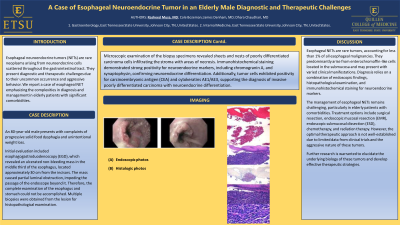Tuesday Poster Session
Category: Esophagus
P3962 - A Case of Esophageal Neuroendocrine Tumor in an Elderly Man: Diagnostic and Therapeutic Challenges
Tuesday, October 29, 2024
10:30 AM - 4:00 PM ET
Location: Exhibit Hall E

Has Audio

Rasheed Musa, MD
East Tennessee State University
Johnson City, TN
Presenting Author(s)
Rasheed Musa, MD, Parth Goenka, , Cole Bozeman, , James Denham, MD, Dhara Chaudhari, MD
East Tennessee State University, Johnson City, TN
Introduction: Esophageal neuroendocrine tumors (NETs) are rare neoplasms arising from neuroendocrine cells scattered throughout the gastrointestinal tract. They present diagnostic and therapeutic challenges due to their uncommon occurrence and aggressive behavior.
Case Description/Methods: An 80-year-old male presented to our clinic with complaints of progressive solid food dysphagia and unintentional weight loss of 30 pounds over the past six months. His medical history was significant for hypertension, peripheral vascular disease (PVD), and gastroesophageal reflux disease (GERD).
Initial evaluation included esophagogastroduodenoscopy (EGD), which revealed an ulcerated non-bleeding mass in the middle third of the esophagus, located approximately 30 cm from the incisors. The mass caused partial luminal obstruction, impeding the passage of the endoscope beyond it. Therefore, the complete examination of the esophagus and stomach could not be accomplished. Multiple biopsies were obtained from the lesion for histopathological examination.
Microscopic examination of the biopsy specimens revealed sheets and nests of poorly differentiated carcinoma cells infiltrating the stroma with areas of necrosis. Immunohistochemical staining demonstrated strong positivity for neuroendocrine markers, including chromogranin A, and synaptophysin, confirming neuroendocrine differentiation. Additionally, tumor cells exhibited positivity for carcinoembryonic antigen (CEA) and cytokeratins AE1/AE3, supporting the diagnosis of invasive poorly differentiated carcinoma with neuroendocrine differentiation.
Discussion: Esophageal NETs are rare tumors, accounting for less than 1% of all esophageal malignancies. They predominantly arise from enterochromaffin-like cells located in the submucosa and may present with varied clinical manifestations. Diagnosis relies on a combination of endoscopic findings, histopathological examination, and immunohistochemical staining for neuroendocrine markers.
The management of esophageal NETs remains challenging, particularly in elderly patients with comorbidities. Treatment options include surgical resection, endoscopic mucosal resection (EMR), endoscopic submucosal dissection (ESD), chemotherapy, and radiation therapy. However, the optimal therapeutic approach is not well-established due to limited data from clinical trials and the aggressive nature of these tumors.
Further research is warranted to elucidate the underlying biology of these tumors and develop effective therapeutic strategies.

Disclosures:
Rasheed Musa, MD, Parth Goenka, , Cole Bozeman, , James Denham, MD, Dhara Chaudhari, MD. P3962 - A Case of Esophageal Neuroendocrine Tumor in an Elderly Man: Diagnostic and Therapeutic Challenges, ACG 2024 Annual Scientific Meeting Abstracts. Philadelphia, PA: American College of Gastroenterology.
East Tennessee State University, Johnson City, TN
Introduction: Esophageal neuroendocrine tumors (NETs) are rare neoplasms arising from neuroendocrine cells scattered throughout the gastrointestinal tract. They present diagnostic and therapeutic challenges due to their uncommon occurrence and aggressive behavior.
Case Description/Methods: An 80-year-old male presented to our clinic with complaints of progressive solid food dysphagia and unintentional weight loss of 30 pounds over the past six months. His medical history was significant for hypertension, peripheral vascular disease (PVD), and gastroesophageal reflux disease (GERD).
Initial evaluation included esophagogastroduodenoscopy (EGD), which revealed an ulcerated non-bleeding mass in the middle third of the esophagus, located approximately 30 cm from the incisors. The mass caused partial luminal obstruction, impeding the passage of the endoscope beyond it. Therefore, the complete examination of the esophagus and stomach could not be accomplished. Multiple biopsies were obtained from the lesion for histopathological examination.
Microscopic examination of the biopsy specimens revealed sheets and nests of poorly differentiated carcinoma cells infiltrating the stroma with areas of necrosis. Immunohistochemical staining demonstrated strong positivity for neuroendocrine markers, including chromogranin A, and synaptophysin, confirming neuroendocrine differentiation. Additionally, tumor cells exhibited positivity for carcinoembryonic antigen (CEA) and cytokeratins AE1/AE3, supporting the diagnosis of invasive poorly differentiated carcinoma with neuroendocrine differentiation.
Discussion: Esophageal NETs are rare tumors, accounting for less than 1% of all esophageal malignancies. They predominantly arise from enterochromaffin-like cells located in the submucosa and may present with varied clinical manifestations. Diagnosis relies on a combination of endoscopic findings, histopathological examination, and immunohistochemical staining for neuroendocrine markers.
The management of esophageal NETs remains challenging, particularly in elderly patients with comorbidities. Treatment options include surgical resection, endoscopic mucosal resection (EMR), endoscopic submucosal dissection (ESD), chemotherapy, and radiation therapy. However, the optimal therapeutic approach is not well-established due to limited data from clinical trials and the aggressive nature of these tumors.
Further research is warranted to elucidate the underlying biology of these tumors and develop effective therapeutic strategies.

Figure: Esophageal NET endo and histo
Disclosures:
Rasheed Musa indicated no relevant financial relationships.
Parth Goenka indicated no relevant financial relationships.
Cole Bozeman indicated no relevant financial relationships.
James Denham indicated no relevant financial relationships.
Dhara Chaudhari indicated no relevant financial relationships.
Rasheed Musa, MD, Parth Goenka, , Cole Bozeman, , James Denham, MD, Dhara Chaudhari, MD. P3962 - A Case of Esophageal Neuroendocrine Tumor in an Elderly Man: Diagnostic and Therapeutic Challenges, ACG 2024 Annual Scientific Meeting Abstracts. Philadelphia, PA: American College of Gastroenterology.
